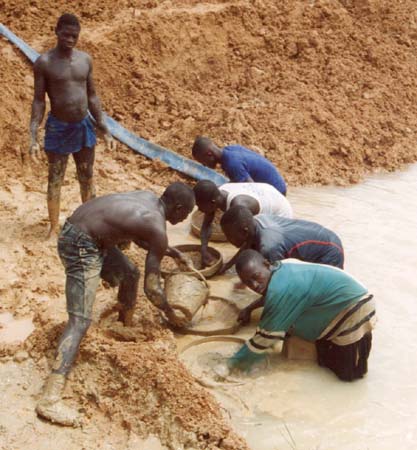
Diamonds have always possessed a treasured place in the human conscious. The history of diamonds stretches back to the pre-BC era. It has been mentioned in ancient Sanskrit and Greek literature and reference can be found in even earlier scripts. To this day, diamonds continue to set the human fancy on fire.
For the most part of the history, diamonds remained a rare stone and the mining process has always been tedious. It begins some 100 miles underground where heat and pressure crystallize carbon into rough diamonds (diamonds that haven’t gone through the polished cut, faceted process, also called natural diamonds). These diamonds reside in kimberlite rocks via kimberlite pipes – vertical structures that contain the kimberlite rocks. Volcanic eruptions, which has occurred millions of years ago brought up these rocks much closer to the earth’s service.
To extract these rocks from the kimberlite pipes, a process called open pit-mining is used, which is a surface mining technique that removes material from an open pit or borrow, with respect to tunneling into the earth, such as longwall mining. Aside from diamond excavation, open-pit mines are also popular for removal of construction material and these mines are commonly known as quarries.
Heavy machinery and hydraulic shovels are required for kimberlite extraction from these open pits and the process of facet checking, cutting, smoothing and polishing begins.
When Did it All Start?
In the early years, wealthy people who can afford everything expensive couldn’t get their hands on diamonds because the stone was so short in supply. However, things changed after 1300 AD when it began to be used as an ornamental stone in medieval Europe.
The real transition, AKA ‘the diamond rush’ occurred in the 19th century, when diamond mines were discovered in different parts of Africa. The gemstone once so rare became available for elites as they were still considered precious and very expensive.
So here we will discuss how the mining of diamonds in different parts of the world has taken its shape from previous millennium to contemporary times.
India: The earliest diamond producer
India was considered to be the place where mining and trading of diamonds started in the 4th century BC. At that time there was no mass scale mining and usually, diamonds were retrieved from rivers, streams and other sedimentary rock formations.
The demand of those Indian diamonds increased in 13 AD when they were introduced in markets of medieval Europe by trade caravans of the time, who were mesmerizing Western Europe with exotic Indian commodities.
Brazil succeeds India
Due to the increased utilization of diamonds by the elites of Europe during the rise of the colonial era, the Indian supply of diamonds began to deplete during the early 16th century. By the same time, Brazil appeared as the major supplier of diamonds along with its already rich resources of gold.
18th century: Africa takes the reins
The dynamics of diamond mining and trade witnessed dynamic changes in the 18th century, when mines were discovered in Africa, including mines in Kimberley and South Africa, the annual production of diamonds increased exponentially in the following years. In the 1870s, the annual yield of diamonds was well under a million carats, but in 50 years, this production reached the mark of 50 million carats. Almost 90% of those mined rough diamonds were coming out of the mines in Africa.

Through the first half of 20th century, South Africa and The Republic of Congo (then Zaire) were responsible for more than 90% supply of diamonds in the world. In the latter half of the century, the Soviet Union also became a big player in the diamond market. The year 1982 became a fortunate year for Botswana, as they became the third largest contributors to the world’s diamond supply, with newly discovered mines. Additionally, mines in Australia and Northern Canada were discovered; thus, making this once fairly unknown mineral a world commodity.
The Ugly side of diamond mining and trade

The symbol of love, luxury and passion can also transform into the manifestation of blood and gore due to the shortcomings of human greed.
In recent decades, the presence of diamond mines in underdeveloped countries in Africa, such as The Republic of Congo, Sierra Leone, Angola, and Liberia have become the reason for civil wars and unrest. Warlords and guerrilla leaders used rough diamonds to finance their rebel movements and to feed their militias, and miners often work in terrible conditions. The diamonds that serve this purpose are called ‘blood diamonds’ or ‘conflict diamonds’.
Angola was a primary source of the illegal diamond trade and was responsible for 20% of the total world production in the 1980s. In order to get a handle on the illegal diamond trade, the UN-appointed Canadian ambassador Robert Fowler to investigate it and in 2000, he produced the Fowler Report, which mentioned the countries involved.
Present status of diamond mining
Apart from some pockets of trouble in those countries mentioned, the supply of the diamond is stable and in safe hands. According to the forecasted figures of 2017, around 142 million carats of diamonds worth $15.6 billion will be mined worldwide. This production volume would be 11% more than the previous year. It is interesting to note that even with these huge volumes of diamond mining as compared to the 19th or 20th century, only 10 mines in the whole world are producing around 60% of global supply of these precious stones.
The largest mine is located in Botswana with the name of Jwaneng, which independently produces 15% value of the world’s diamonds.
No matter how technology-savvy we become, with each passing generation, it may be in our human DNA that we still get spell bounded by the beauty and delicacy of this gem. It seems as if we are far from getting over this obsession. Moreover, this slogan might be true after all that ‘A diamond is forever’.

